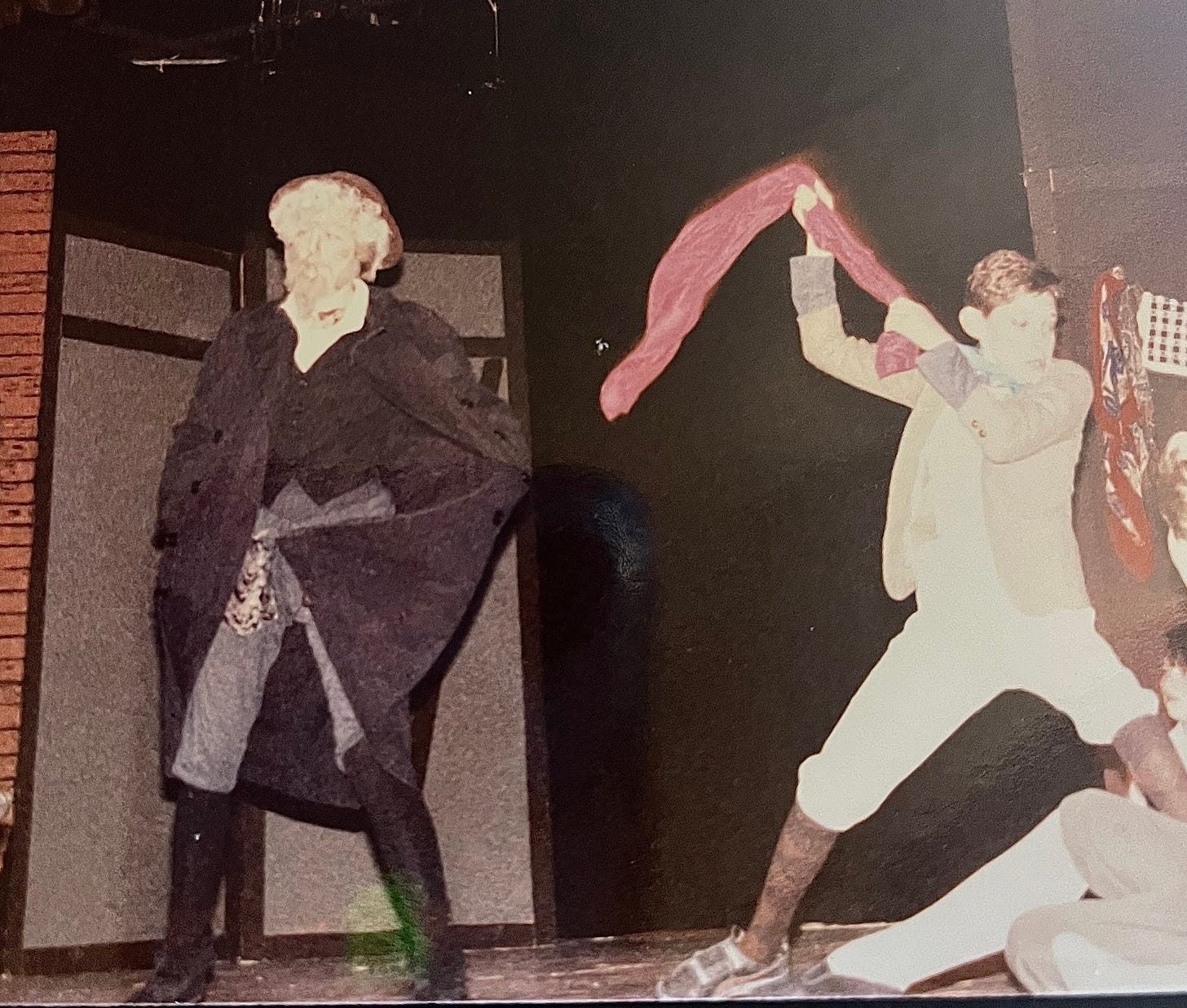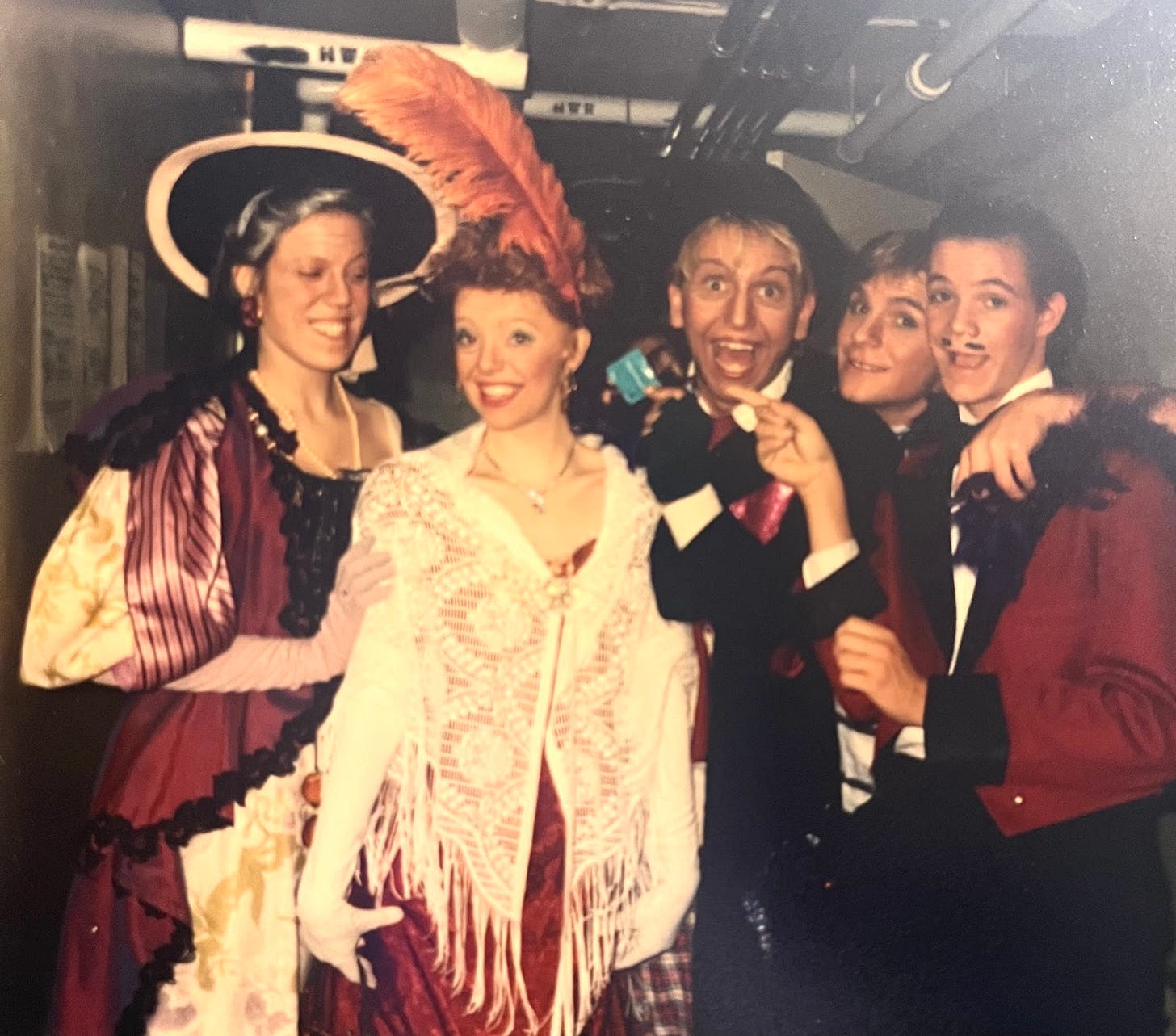Next Time: Chapter 3: You’re Looking Swell, Dolly
[this is a GLOSS on Chapter 3, which has been linked here for your convenience. NOTE: I am no longer re-sending the chapters themselves to your inboxes, but will share them on Substack’s Notes along with the in-gloss links here, from now on. Hope that helps.]
*
I can tell, Dolly…
You’re still growing, you’re still glowing, you’re still going strong…
The title of this chapter and the subtitle above are lyrics from Dolly’s signature number in the musical. You know, the one where she’s coming down the grand steps of the posh hotel and all the dapper waiters are arrayed in adoration as she sings to them? That one.
There’s a silly sewing story that my mom loves to tell and re-tell re:the production of Hello, Dolly at Boulder High (its real name). Basically, what happened is this: Mom gets a call one evening as I’m in rehearsal, from the director of the show, saying, ‘We have an emergency.’
Now, hearing this from your kid’s theatre director has got to be any parent’s worst nightmare. So Mom’s sitting there on the phone thinking, My daughter has had a sand bag drop on her head, or any number of other gnarly things that can happen in a dangerous scenario like a live theatre stage.
Turns out, the ‘emergency’ was that the costume designer had a nervous breakdown and dropped out last minute. They had 20 waiters for the final spectacle number and only two jackets rented. The director had heard that my mom knew how to sew, and she asked if she could create the rest of the 18 jackets. They had the model jackets and the bolts of cloth to make them with, but no patterns. Oh, and they needed them by dress rehearsal which was tomorrow.
To this day, my mom is convinced the director used those dire terms just to get her to jump into action out of pure relief, otherwise she’d never have agreed to do it. I reassured her that no, everything like that is a true emergency in theatre.
She made a pattern from one of the jackets, loosely stitched together all the rest of them in time, and asked me if the actors were doing anything involving big movements, as these jackets she’d quickly cobbled wouldn’t stand up to much, though they’d look fine just wearing them. I told her no. Imagine her near-aneurysm when she came to dress rehearsal and witnessed two of the actors doing *cartwheels* in her mockups! Ahhh, good times.
Look. I’m not stupid, and I’m not ungrateful. I’m also well aware of my look and talent and what goes into both professional and educational productions. Especially as someone who came out of this long education with the opportunity to also be a theatre educator myself later in life, I have all kinds of perspective on this whole thing. But best believe that body image, for girls in particular, is absolutely brutal. In the performing arts fields, exponentially more so. And lest you think, well that was the late ‘80s and the ‘90s. We’ve come a long way, baby! Well, sure. But also, we’ve taken a sharp right turn into women-are-second-class-citizen land lately in this country, and it ain’t pretty. Just like I wasn’t. Ahem.
What I’m saying is: yes, I get it. The pretty girl parts are not nearly as challenging or exciting as the stuff I got to do instead. And that’s true. But that’s beside the point. Julia Doolittle lays out this very conflict beautifully in her essay ‘Not a Pretty Girl’:
Because of course, deep down, none of this was about the part. It wasn’t like I was dying to play the crappy love interests in my school plays because they were fantastic roles. I was in it for the validation. I wanted to be assured by strangers that I was gorgeous and wanted. And after a lifetime of narratives that told me that the only kind of woman worth being was a pretty one, could you blame me?
I also went through a fuck-it-I-give-up-on-femininity reactive phase too, as she describes having done. Though it’s more deep seated for me than a phase, as I’l talk way more about in Chapter 5. So put a pin in that.
On that note: I also do have a realistic enough hindsight, as well as having talked with several people from my life back then (my partner included) who have told me they thought I was the coolest, hottest, most unattainable and elegant posh beauty they’d ever seen at that time (and now). Which I appreciate, even at this far remove. The beauty hierarchy and standards have changed somewhat since back then, and I appreciate that too. And me and my pretty friends all look amazing in our 50s, and my partner just gets hotter and hotter. But he’s a guy. But you know what I’m saying.
What, this old thing?
This may be more of a comment for Chapter 4, but I was just thinking about the fact that these days, the gray in my hair and age in may face is nothing close to as much or even at all like, the lines and spray I was taught how to paint on my face and hair to make me look like my age now (or older, but not always). Wrinkles especially–my face looks way more youthful at nearly 52 than any of those meticulous realistic lines I learned how to draw there in my college makeup class.

Getting to know my new old body has been something of a trip, and one I’ve written about in a few other essays over on Zuko’s Musings (cue ‘Ventripotent,’ among others). Right now I happen to be in winter-bear-or-is-that-Eastern-European-peasant-hibernation body mode, so it’s not real an ideal time to be talking about fatness or damaging body image or false expectations of thinness. It’s an ongoing process, though, and the further I get down Perimenopause Lane, the more interesting it will get. Best believe I will continue to write about it as time (and hormone and therefore body) changes go on.
‘80s druggie skinny supermodel chic is a hard pattern to break, especially if it’s been embedded in the child’s psyche from the beginning. Even as a terrifyingly skinny teen, I still had a bit of lordosis (oo, another cool vocab word!) in my lower back, which tilted my pelvis forward, which perforce would make my belly hang out more than it would have. Now, that wasn’t fat at that time, just, yanno. Internal organs. But in a world where Kate Moss was the pinnacle of beauty, and even my best friend irl was thin as a whip, it was an image I hated. And of course, as we all know, the entertainment world only has room for thin women. Thin, pretty, petite women. Back then, even though I was thin, I wasn’t pretty nor was I small, and therefore I din’t fit the beauty bill. I was also super-intelligent and nerdy, which made me even less castable (or dateable)...
The confusion surrounding Equity that I touched on here and especially the changes to it that I describe in the footnote? I haven’t really seen much about what kind of value AEA brings to the actor’s table at all since then. It’s a mystery. Back when I was just graduating with my BFA in Acting (that would be late 1995), I made a point to not get my Equity card, so as to make myself more castable in Denver. Which made sense at that point, but I have no idea how it works these days what with the changes. My observation of this admittedly active theatre city is that it’s the same people getting cast in the same places, same as it ever was. So. Dunno.

*
TODAY’S BIBLIOGRAPHY:
Arabi, Shahida. Power–Surviving and thriving after narcissistic abuse. Brooklyn, NY: Thought Catalog Books, 2017.
Doolittle, Julia. ‘Not a Pretty Girl.’ From Julia Does a Lot, July 17, 2017. (Link)
Zuko, Jenn. ‘Ventripotent.’ From Zuko’s Musings, Jan. 12, 2024. (Link)



